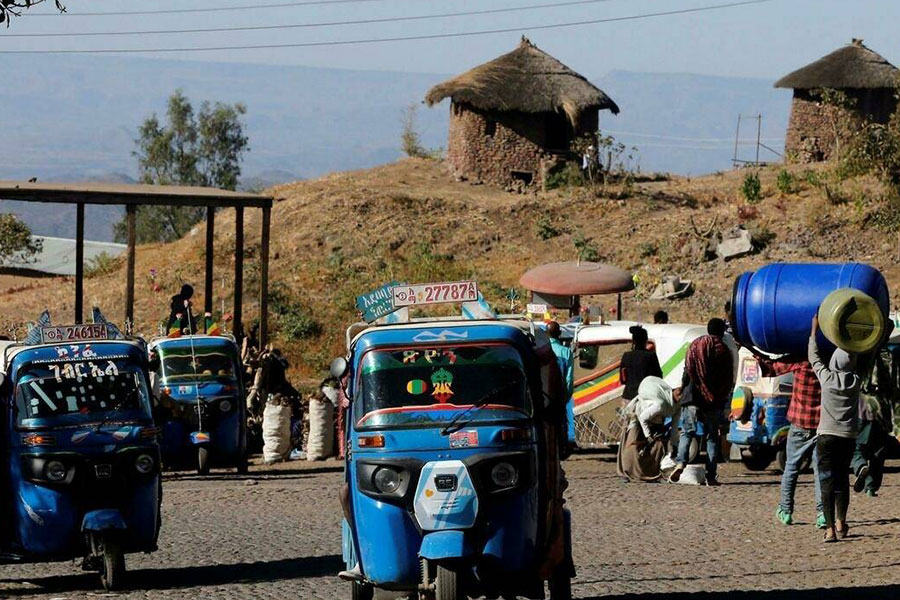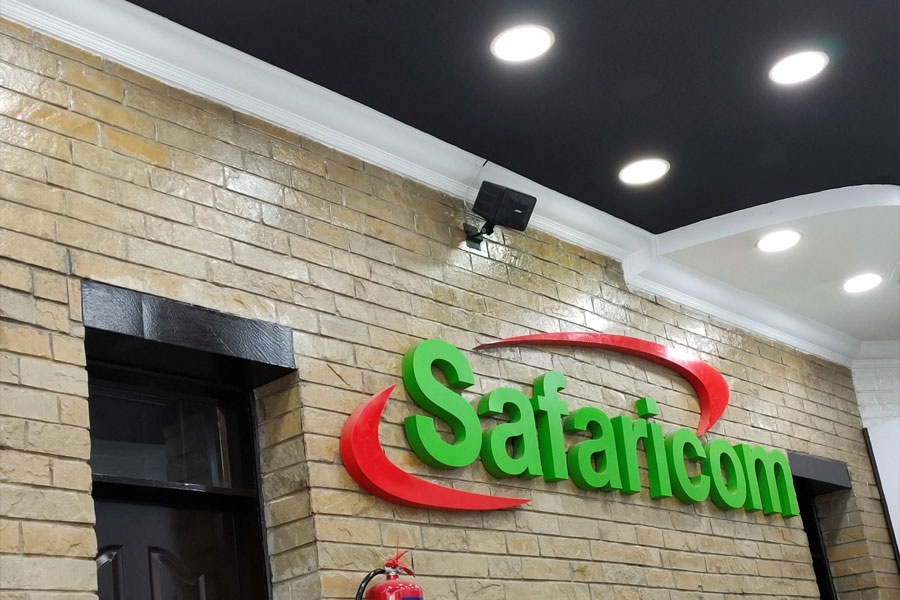
On a side road across the African Union Headquarters, in Lideta District, lies a whole body painted makeshift bus-turned-stall serving as a distribution centre for bread. Registered under Werkenesh Melaku & Friends, the stall was opened last year by six people with 80,000 Br borrowed from a microfinance institution. It is one of the many hundreds of former Anbessa City Bus scattered.
The bread comes from Sheger Bread & Flour Factory, a recently opened industrial-scale bakery in the outskirts of Addis Abeba. The stall was supplied with as much as 3,000 loaves of bread a day in the early days. In recent weeks, no more than 1,200 loaves have made it to the shelves.
On the morning of Thursday, December 16, 2021, the stock of 1,200 pieces of bread, packed in 10 and 20 Br bundles, ran out in less than two hours. Dozens of customers were turned away. At least, the supply would be sufficient to cover the needs of around 120 people, as a single buyer is limited to 12 loaves, for 20 Br.
Supplies running out so quickly does not amount to good news for the owners. Instead, it makes them wary of the rising costs they incur in light of fewer sales.
When the Sheger Bread & Flour Factory venture was kicked off last year as a collaboration between MIDROC Investment Group and the Addis Abeba City Administration, the stall owners in Lideta had high hopes of running a profitable business. The 3,000 loaves they received daily translated into 18,000 Br in monthly profits, sufficient to cover rent and interest payments on the loan they took to establish their stall. The profit margin from each loaf of bread stood at twenty cents.
They pay 1,035 Br in monthly rent for the stall to the City Administration. It was initially 690 Br, but the stall owners would not say they were unaware of the eventual increase. The contract they signed with the administration says rent could increase until it hits 1,385 Br a month at the end of this year. With the 5,000 Br in monthly loan repayment and the 42,000 Br they shell out for the supply of bread; expenses have put the business under stress.
The Association barely nets 7,200 Br a month from the business now, a little more than 1,000 Br for each member. One of these members, who depends on the stall to support three children, says life would have been impossible to sustain had it not been for the income generated by her spouse.
Around two months ago, following discussions with distributors, the wholesale price was increased by 40 cents a loaf, pushing the retail price up by the same amount to 1.5 Br. Even with the increase, low-income households still prefer to buy from shops that distribute Sheger Bread since a loaf of bread in other markets across the city goes for at least 3.50 Br.
Solomon Kebede, a 50-year-old father of two, working as security personnel around the Sarbet area, is a frequent customer at Sheger retail shops.
“The bread is of higher quality compared to others in the market, not to mention the lower price,” he told Fortune.
The Agricultural Transformation institute pilot cluster farm of 300 weredas where 3.6 million farmers are signed up.
But this comes at a considerable cost to the company. The problem lies with a chronic shortage of wheat and the ever-increasing cost Sheger Bread faces. It cost the company 2.5 Br to bake a loaf of bread while loaves were distributed at 1.30 Birr and retailed at a little over one Birr. The factory recorded a loss of 140 million Br last year.
Sheger Bread & Flour Factory, located in Akaki Kality District, was established last year with a 900 million Br investment. The plan was to supply two million loaves of bread a day at a subsidised cost. With a design capacity to bake about 80,000 pieces of bread an hour, it is the first industrial-scale bakery supplying over 380 cooperatives and designated shops across the city.
The bakery sources inputs from the market and receives 60,000 quintals of wheat a month through the Addis Abeba Trade Bureau at a subsidised price, according to Daniel Miesa, communications head at the Bureau. The City Administration also shares the balance between the bakery cost and the wholesale price. Although a disparity is seen among flour mills and bakeries, most have seen their fair share of struggles to source wheat from the local market over the past two years.
Yared Tilahun is the general manager of Acha Food Complex, established eight years ago. Acha sources wheat from producers in Bale, Oromia Regional State, and operates a mill in Gelan, in the outskirts of Addis Abeba.
"The price has gotten high, but it's available," said Tilahun.
A quintal of flour retails for as high as 4,200 Br, a 400 Br jump from the end of last year. The rise is consistent with a broader trend where a basket of food prices has increased, pushing inflation to 38.9pc last month. According to the Ethiopian Statistical Service, the price of bread and cereals recorded a 42.8pc annual growth.
Although Acha Food can produce 820tn of flour a day, it operates at less than half its capacity.
“We can kick up our production to full if we don't have to compete with imported flour,” says the manager.
Rising prices and supply constraints can be traced back to low agricultural productivity and underdeveloped mechanised farming. Low output in tandem with fast-growing demand has led to a significant amount of foreign currency spent every year on imported wheat.
The annual demand for wheat is estimated to be about 7.6 million tonnes, close to three-fold more than what the country needed in the 1990s. Over 4.5 million smallholder subsistence farmers have been producing more than two-thirds of this, leaving a 1.8 million tonne in shortfall. The federal government spends about 700 million dollars annually to buy wheat from the outside, which has grown from 600,000tn to 1.7 million tonnes a year over a decade. However, the past two years have been rocky as several attempts to buy wheat have failed.
The latest attempt was last month, and it remains to be seen whether it is a success. The Ethiopian Trading Businesses Corporation (ETBC) tried to interest suppliers for 400,000tn of wheat. Although three suppliers turned up, the procurement process remains clouded in uncertainty as bidders failed to offer for all lots. One bidder could not provide a bid security bond, a ground for disqualification under the public procurement guidelines.
The management will decide on the outcome this week, disclosed Ketsela Shewarega, deputy CEO of corporate operations at the ETBC.
The authorities at the federal government had ended a streak of failed attempts at wheat procurement earlier this year, buying 400,000tn through the United Nations Office for Project Services (UNOPS) for 11 billion Br, including freight and transportation costs. Another shipment of the same volume is expected to arrive in the coming months. The Ministry of Trade & Regional Integration is drawing up plans to distribute this wheat in the coming week, disclosed Ashenafi Mamuye, the Ministry`s head of the team responsible for market research and monitoring fast-moving consumer goods.
The recent wheat procurement attempts may be encouraging news for officials and markets. But it does little to address the issues with the national grain production.
Experts and officials in the agricultural sector are keen on promoting cluster and irrigation-based off-season wheat farming. The Agricultural Transformation Institute (ATI) began piloting the cluster farming initiative three years ago, targeting the scattered nature of smallholder farmers. On average, a farming household possesses around 0.8ht of land. There are an estimated 18 million farming households.
Close to 300 weredas were selected, in which 3.6 million farmers have been organised into clusters totalling 2.5 million hectares. The smallest size is 17ht, where 10 crops, including maize, wheat, sesame, avocado and mango, are produced. The Ministry of Agriculture follows up on the outcome of this experiment, scaling up the project to include more weredas.
It is strenuous to try and reach all through extension programmes, according to Dagnachew Lule (PhD), senior director of the agricultural commercialisation cluster at the Institute. Experts like Dagnachew hope to see the cluster programme enable an extension worker to reach out to several farmers, with easier access to inputs for farmers, and cut costs on mechanisation equipment.
The irrigation-based wheat farming piloted in four regional states is organised into clusters by default. The project has seen wheat yields, on average 32 quintals a hectare, go to as high as 103 quintals in exceptional cases.
"Even if we assumed this was exceptional and if we can increase the average productivity to 42 quintals a hectare, we'd be able to meet the demand," said Dagnachew.
Many farmers have yet to adopt modern technologies, the reason why seasonal harvest is low. Only 30pc of farmers are believed to have the practice of using modern farming technologies, according to Dagnachew.
Close to 300,000ht of land was expected to be harvested through irrigation and fall season harvest last year in the Oromia, Amhara, Afra, Tigray, Sidama, and Southern regional states, of which about 172,000 was achieved. Close to 700,000 tonnes of wheat was produced with an increased average yield rate of 40qt a hectare.
It could go higher than that, says Dagnachew.
This year, 400,000hct of land is planned to be harvested, of which one-fourth has already been achieved. Among the regions, Oromia takes the highest share with 75pc.
An agricultural economist who has been a member of the executive committee at the Ethiopian Economics Association (EEA) applauds the government's efforts to expand large-scale farming but observes some obstacles that need removing.
“The initiative still faces problems such as access to improved seeds,” he said.
According to the expert, small-scale farmers who are already engaged in wheat cultivation should also be given attention. Wheat cultivation contributes significantly to small-scale farming households in food security, particularly in the highland areas. The central, south-eastern and northwestern parts are the main wheat-growing belt of Ethiopia.
Assefa Admassie (PhD), an agricultural economist, also believes the efforts are a step in the right direction. Nevertheless, he argues that land policies need to be revised to incentivize farmers to produce more.
Government efforts to boost domestic productivity could pay off in the future, but for the moment, people like Solomon have little choice but to rise at the crack of dawn and line up at a Sheger Bread stall for their daily bread. If they are lucky, they would be able to buy some before the bread is all sold out for the day.
PUBLISHED ON
Dec 19,2021 [ VOL
22 , NO
1129]

Agenda | Nov 06,2021

Viewpoints | Jul 15,2023

Films Review | Jul 25,2020

Fortune News | Aug 05,2023

Fortune News | May 21,2022

Fortune News | Jun 05,2021

Fortune News | Mar 17,2021

Fortune News | May 02,2020

Editorial | May 15,2021

Fortune News | Dec 11,2021

Dec 22 , 2024 . By TIZITA SHEWAFERAW
Charged with transforming colossal state-owned enterprises into modern and competitiv...

Aug 18 , 2024 . By AKSAH ITALO
Although predictable Yonas Zerihun's job in the ride-hailing service is not immune to...

Jul 28 , 2024 . By TIZITA SHEWAFERAW
Unhabitual, perhaps too many, Samuel Gebreyohannes, 38, used to occasionally enjoy a couple of beers at breakfast. However, he recently swit...

Jul 13 , 2024 . By AKSAH ITALO
Investors who rely on tractors, trucks, and field vehicles for commuting, transporting commodities, and f...

Jul 12 , 2025
Political leaders and their policy advisors often promise great leaps forward, yet th...

Jul 5 , 2025
Six years ago, Ethiopia was the darling of international liberal commentators. A year...

Jun 28 , 2025
Meseret Damtie, the assertive auditor general, has never been shy about naming names...

Jun 21 , 2025
A well-worn adage says, “Budget is not destiny, but it is direction.” Examining t...